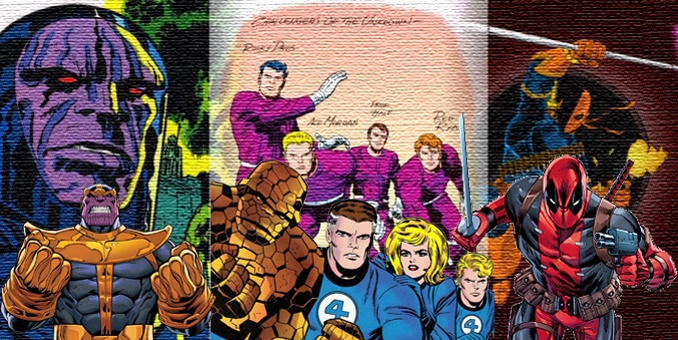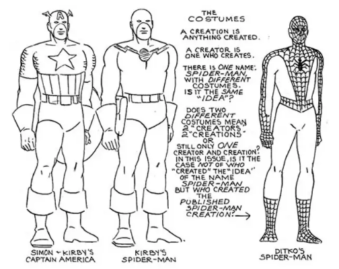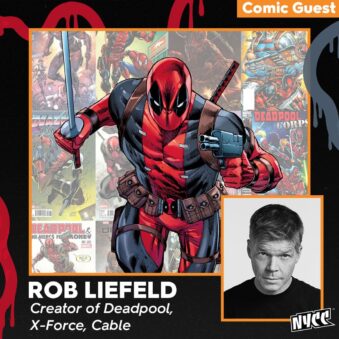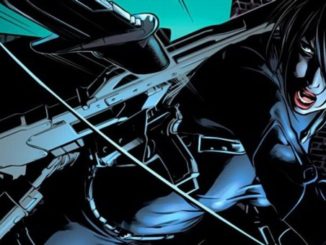
Jack Kirby created Thanos.
Yes, you read that right. I said that Jack Kirby, the King of Comics, created Thanos. Forget the fact that he wasn’t working at Marvel at the time, let alone writing or drawing Iron Man #55, where the character first appeared.
See, Jack Kirby created Darkseid in 1970 as part of his “Fourth World” series over at DC. The character became quite popular. This, of course, did not go unnoticed by Kirby’s old employer, Marvel Comics. Jim Starlin, writer of that issue of Iron Man, was inspired by Kirby’s Fourth World and in an interview in Comic Book Artist #2, detail how that played into Thanos’ origin:
In my first Thanos drawings, if he looked like anybody, it was Metron. I had all these different gods and things I wanted to do, which became Thanos and the Titans. Roy took one look at the guy in the Metron-like chair and said : “Beef him up! If you’re going to steal one of the New Gods, at least rip off Darkseid, the really good one!”.
There you go. The blue-clad, craggy purple skinned Thanos was a rip of of Jack Kirby’s blue-clad, craggy purple skinned Darkseid. So, Jack Kirby deserves credit in creating Thanos.
You don’t agree? I mean, we wouldn’t have a Thanos if it wasn’t for Darkseid, but, okay. Then how about Roy Thomas? Should he get credit for influencing the design of the character? How about Mike Friedrich? He was scripter on the issue. In other words, he put words in the characters mouth. Should he be listed as co-creator?
This is the problem with assigning credit in comic books, what I touched on in the article that started this series off. People want a simple one or two person creator team that they can hold up as the creative geniuses behind the character. However, that doesn’t take into consideration that certain partnerships are not 50/50, that certain characters are, for lack of a better term, rip offs of other characters, or that dozens of creators work on a character over its lifetime.
 One of the most notorious cases of “who created what” is the case of Stan Lee and Jack Kirby and the creation of the Fantastic Four. Lee has always claimed sole credit for the idea behind the group, saying he was going to quit comics to do work that stimulated him when he was asked to create a superteam by Marvel’s owner Martin Goodman. His wife convinced him to do the superhero story he wanted to do, and the Fantastic Four was born.
One of the most notorious cases of “who created what” is the case of Stan Lee and Jack Kirby and the creation of the Fantastic Four. Lee has always claimed sole credit for the idea behind the group, saying he was going to quit comics to do work that stimulated him when he was asked to create a superteam by Marvel’s owner Martin Goodman. His wife convinced him to do the superhero story he wanted to do, and the Fantastic Four was born.
Kirby, on the other hand, states he came into Marvel’s office as they were about to go out of business–he said in some anecdotes that they were taking out the furniture when he was there–and he went to the despondent Lee and told him that he would save the company. And he did, creating pretty much every Marvel character from the Fantastic Four to Thor to even Spider-Man.
Both stories seem outlandish–romantic constructions to make each of them look good in the eyes of others–but there is one thing that lends credence to Kirby’s argument. The Fantastic Four bared a striking similarity to comic book Kirby created four years prior.
 In 1957, Jack Kirby created the Challengers of the Unknown. They were a team of adventurers who escaped a horrible plane crash unscathed and decided that they were living on borrowed time. As such, they decided to band together to “challenge the unknown.”
In 1957, Jack Kirby created the Challengers of the Unknown. They were a team of adventurers who escaped a horrible plane crash unscathed and decided that they were living on borrowed time. As such, they decided to band together to “challenge the unknown.”
There have been entire websites pointing out the similarities between the two concepts and their first stories, but let me just list the Challengers characters to show how they match up.
- Walter Mark “Prof” Haley: scientific genius and de facto leader of the group, much in the same role Reed Richards/Mr. Fantastic plays in the FF.
- Leslie “Rocky” Davis and Kyle “Ace” Morgan: Davis was a gruff Olympic wrestler with more strength than smarts and Morgan was a fearless jet pilot. Both men seem to have been combined in the form of Ben Grimm/The Thing.
- Matthew “Red” Ryan: A brash and impetuous daredevil whose personality mimics Johnny Storm/The Human Torch.
- June Robbins: a female scientist who joins the team in a later adventure who acts as the heart and soul of team, much like Sue Storm/Invisible Girl.
So, yes, the two teams are very similar. But there was something that made the Fantastic Four and enduring institution and the the Challengers of the Unknown a minor part of the DC Universe. And, in my opinion, that would be Stan Lee.
The division of labor between Lee and Kirby is a contentious subject amongst comic book fans. Give Stan too much credit, and Kirby’s supporters will put you in your place. Give Jack the upper hand an the Lee faithful will smack you down. Nobody really knows how the partnership truly worked. Each man gave their own self-serving versions of the creative process up until the day he died (although Lee was more free with giving Kirby credit at various times of his life). It is up to us fans to try to work our how the sausage was made.
How do I think it was done? I think Lee would give a plot idea to Kirby. It could have been just a sentence, or it could be an in-person session with Lee acting out all the characters. He would then let Kirby go and created the story as he saw fit. Kirby would bring his artwork back into the office. Lee, as Editor, would have Kirby make any changes or as scripter, add the dialogue to artwork. Did Kirby do the lion’s share of the plotting? Yes. Was Lee’s contributions negligible? No.
Let’s discuss Kirby claiming to have created Spider-Man. In another case of “he said/he said,” Jack Kirby claimed that one day he walked into Stan Lee’s office and said “Why don’t we do a hero called Spiderman.” Lee recalls the origin of the concept as his wanting to create a teen hero. When thinking of a power set for the character, he saw a fly walking on the wall. Since there was already a character named “The Fly,” Lee made it a spider instead and Spider-Man was born. We will never know who is telling the truth, as it is Lee’s word against Kirby’s, both are dead and there was no one else there to confirm either one’s story.
 What seems to have definitely happened is that Kirby created a five-page story with his take on the character. His Spider-Man was a reworking of a concept he had created with Joe Simon called the Silver Spider, a concept Simon himself borrowed from to create a revamp of the Fly in 1959. Kirby’s Spider-Man was a teenage boy who was living with his aunt and hard-nosed ex-cop uncle who finds a magic ring that turns him into an adult. This ring also gave him the power to walk on walls and a gun that allowed him to shoot webs. Lee didn’t like Kirby’s take on the character, so he took the concept to Steve Ditko and the rest is history.
What seems to have definitely happened is that Kirby created a five-page story with his take on the character. His Spider-Man was a reworking of a concept he had created with Joe Simon called the Silver Spider, a concept Simon himself borrowed from to create a revamp of the Fly in 1959. Kirby’s Spider-Man was a teenage boy who was living with his aunt and hard-nosed ex-cop uncle who finds a magic ring that turns him into an adult. This ring also gave him the power to walk on walls and a gun that allowed him to shoot webs. Lee didn’t like Kirby’s take on the character, so he took the concept to Steve Ditko and the rest is history.
Hardcore Kirby fans have gone out of their way to use this a proof that Kirby created Spider-Man and deserves credit for it. Kirby’s heirs listed Spider-Man as part of their copyright termination filing in 2009. But even if Kirby’s version of events are accurate, does he deserve full credit for creating Spider-Man? He came up with the name, the fact the teen lived with his aunt and uncle, and his ability to climb walls and shoot webs. Call me a cynic, but having a character named Spider-Man climb walls and shoot webs doesn’t seem like an idea only the great Jack Kirby could come up with. And the other elements carried over had little effect on the character’s popularity and longevity.
Steve Ditko didn’t seem to think Kirby deserved creator credit. He appeared to take Kirby’s attempt to grab credit personally, and responded in an essay in 2002 explaining the creation of Spider-Man as he saw it.He makes the argument that the only valid comic book creation is one that is published. Kirby’s proposal was not, so he should not be given credit as the creator in any way, shape or form. Yet “Kirby as Spider-Man’s creator” still gets support amongst Kirby fans, not realizing that it diminishes Ditko’s major contributions to the character.
 The next case of dubious creator-ship involves a more modern character. One with a successful movie franchise. The Merc With a Mouth, Deadpool.
The next case of dubious creator-ship involves a more modern character. One with a successful movie franchise. The Merc With a Mouth, Deadpool.
As you can see to the right, in an ad for his upcoming appearance at New York Comic Con, Rob Liefeld is listed as the sole creator of Deadpool. Many accept this as the truth. After all, Liefeld plotted and drew the character’s first appearance in New Mutants #98. He certainly is the guy the media goes to for interviews about the character. But the Deadpool Liefeld created barely resembles the one that was featured in the hit movies.
 First off, like Thanos and the Fantastic Four, Deadpool was based on an older, more established character. Liefeld was a fan of the Teen Titans, and his first drawings of the character caused his co-workers to remark how similar it was to Teen Titans villain Deathstoke the Terminator. The resemblance caused Deadpool civilian identity to be named “Wade Wilson” in a nod to Deathstroke’s alter ego, Slade Wilson.
First off, like Thanos and the Fantastic Four, Deadpool was based on an older, more established character. Liefeld was a fan of the Teen Titans, and his first drawings of the character caused his co-workers to remark how similar it was to Teen Titans villain Deathstoke the Terminator. The resemblance caused Deadpool civilian identity to be named “Wade Wilson” in a nod to Deathstroke’s alter ego, Slade Wilson.
In his first appearances, Deadpool was a vicious killing machine. Only by his fourth or fifth appearance did wisecracks start appearing in his dialogue–something Liefeld had little control over. Fabian Nicieza worked Liefeld as a scripter, which, as we mentioned above is a person who provides the dialogue the comic character speaks. Logic dictates that those wisecracks came from the mind of Nicieza and not Liefeld.
Although, Liefeld wouldn’t like you to know that. In an infamous 2016 New York Times interview, Liefeld more than willingly took credit for the character’s humor and compared Nicieza to a “janitor” who rode his coattails to co-creator status.
Liefeld was only at Marvel to shepherd in the characters first seven appearances before he left to form Image. And a lot of those seven appearances were cameos as small as one panel. The heavy lifting of turning the vicious mercenary into an anti-hero with a heart of gold was done by the writers and artists that came after him. Most notably Joe Kelly and Ed McGuinness.
Kelly and McGuinness were the writer and artist on Deadpool’s first ongoing series in 1997. The pair amped up the humor and lightened the character so that a wider audience could identify with him. They also instilled the character’s habit of breaking the fourth wall. It was their version that shaped every appearance of the character going forward. It was this later period Deadpool that attracted Ryan Reynolds to the character. And it was this version of the character that appears on the big screen. Yet Rob Liefeld gets all the attention and Kelly and McGuinness didn’t even get a special thanks until Deadpool 2.
This all goes to elaborate my original point. Assigning credit for creating comic characters isn’t as simple as rewarding the creators that appear on the first page of their first appearance. Some times it takes a lot of hand to create and endearing character. And if you don’t do you due diligence, worthy artists will be snubbed.
Next Time: we look at the art of the pastiche where lack of originality does not always mean a lack of creativity.




